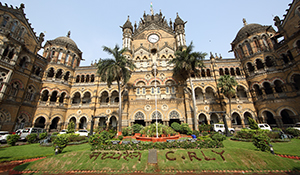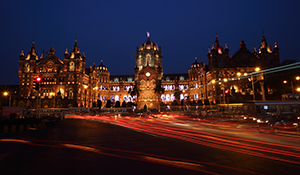 Chhatrapati Shivaji Terminus (CST) was originally built by the British in 1887 to celebrate Queen Victoria’s Golden Jubilee, but since then, it has become the most important transport hub in the world's busiest commuter rail network. As well as being a UNESCO World Heritage Site, every day over 1,250 local and long-distance trains pull in and out of its 18 platforms. Together, they carry around three million passengers – that’s more people than travel on the entire British railway network per day.
Chhatrapati Shivaji Terminus (CST) was originally built by the British in 1887 to celebrate Queen Victoria’s Golden Jubilee, but since then, it has become the most important transport hub in the world's busiest commuter rail network. As well as being a UNESCO World Heritage Site, every day over 1,250 local and long-distance trains pull in and out of its 18 platforms. Together, they carry around three million passengers – that’s more people than travel on the entire British railway network per day.
The station complex is spread over nearly thirty thousand square metres; there are seven suburban platforms and eleven more that connect it to the rest of India. The suburban concourse is the core of Mumbai’s commuter network, with tens of thousands of people pouring through the station at all times of day. On first sight, it may look like there aren't any doors on the trains – actually, there are but they never get closed on this network. In 1990, CST introduced double discharge platforms allowing passengers to get on and off from both sides. The other thing allows the huge amounts of people to navigate the station is the fact there are no bottle necks caused by ticket barriers barring the exit. Commuters can just pile off the train and get straight to work.
All this is because of the ‘headway’ – what the station’s control team call the turnaround time between getting trains in and out of the station. In order to keep this massive operation on schedule, they must keep the headway period to the minimum time possible. In peak hours, trains enter and exit each platform every three minutes and thirty seconds. Maintaining the network and organising all these trains, platforms and people is incredibly complicated, and relies on complex maths, system control and automation.
 On top of that, to maintain the headway, commuters only have fifteen to thirty five seconds while the train stops to get on or off. Many jump out of the open doors whilst the train is still in motion. Tragically accidents are commonplace - nine people are killed on Mumbai suburban network every day, with commuters falling from the trains or run over as they cross the tracks.
On top of that, to maintain the headway, commuters only have fifteen to thirty five seconds while the train stops to get on or off. Many jump out of the open doors whilst the train is still in motion. Tragically accidents are commonplace - nine people are killed on Mumbai suburban network every day, with commuters falling from the trains or run over as they cross the tracks.
Mumbai’s supersized station is vital to a city constantly in a state of gridlock, where rail beats roads in being the fastest, easiest and cheapest way of getting around. However, in India’s busiest city, this means Mumbai has the most densely packed trains in the world. The ‘super dense crush load’ of the commuter network’s peak times is no exaggeration - up to 5000 passengers cram themselves into - or sometimes even on top of - trains built to hold only 1200. To compare – a rush hour service between Leeds and Manchester, running at full capacity, would take under 1000 people. Whereas, inside each of the Mumbai train’s 12 carriages, as many as fourteen people can be crammed into a single square metre, the same size as a phone box.
Rail fares are subsidised by the Indian government, and many commuters buy a monthly pass. As well as having separate carriages – and sometimes even separate trains – for men and women, the trains also have a first and a second class. In first class, a pass will set you back 745 rupees (around £7.45), however in second class, it's only 215 rupees. The price difference doesn’t indicate that much more comfort though – the only difference is that the first class seats are padded, but the second class aren't - not much comfort when there’s standing room only.
- Read more about The world's busiest railway - Mumbai, India and rail.
- Find out more about The world's busiest railway 2015 - Mumbai Railway on TV.
- Explore more free learning from the Open University.


Rate and Review
Rate this article
Review this article
Log into OpenLearn to leave reviews and join in the conversation.
Article reviews